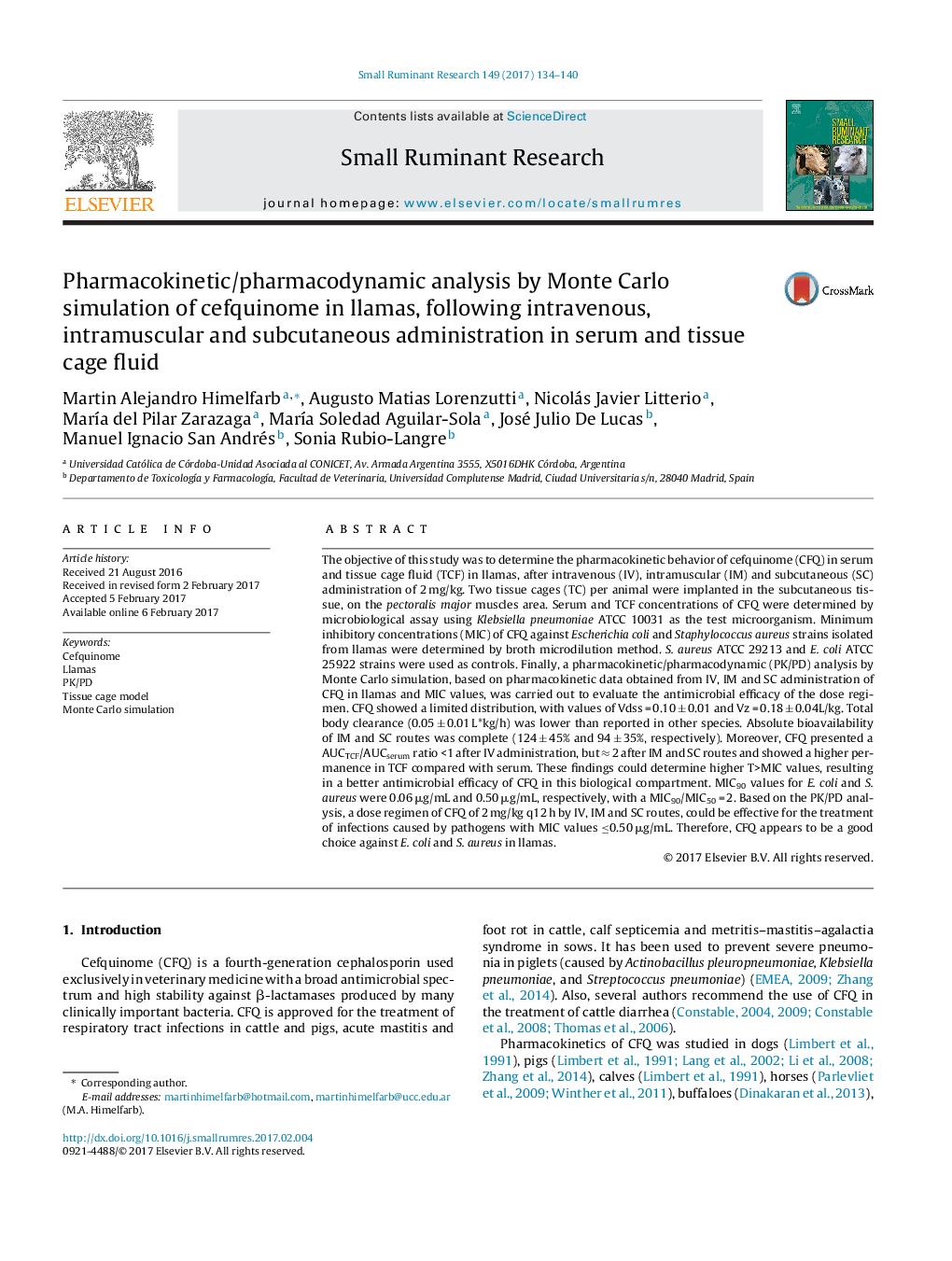| کد مقاله | کد نشریه | سال انتشار | مقاله انگلیسی | نسخه تمام متن |
|---|---|---|---|---|
| 5544277 | 1554343 | 2017 | 7 صفحه PDF | دانلود رایگان |
عنوان انگلیسی مقاله ISI
Pharmacokinetic/pharmacodynamic analysis by Monte Carlo simulation of cefquinome in llamas, following intravenous, intramuscular and subcutaneous administration in serum and tissue cage fluid
ترجمه فارسی عنوان
تجزیه و تحلیل فارماکوکینتیک / فارماکودینامیک با استفاده از شبیه سازی سیمفکینوم مونت کارلو در لاماها، پس از تزریق داخل وریدی، تزریق عضلانی و تزریقی زیر در داخل سلول های قفسه سینه و سرم
دانلود مقاله + سفارش ترجمه
دانلود مقاله ISI انگلیسی
رایگان برای ایرانیان
موضوعات مرتبط
علوم زیستی و بیوفناوری
علوم کشاورزی و بیولوژیک
علوم دامی و جانورشناسی
چکیده انگلیسی
The objective of this study was to determine the pharmacokinetic behavior of cefquinome (CFQ) in serum and tissue cage fluid (TCF) in llamas, after intravenous (IV), intramuscular (IM) and subcutaneous (SC) administration of 2 mg/kg. Two tissue cages (TC) per animal were implanted in the subcutaneous tissue, on the pectoralis major muscles area. Serum and TCF concentrations of CFQ were determined by microbiological assay using Klebsiella pneumoniae ATCC 10031 as the test microorganism. Minimum inhibitory concentrations (MIC) of CFQ against Escherichia coli and Staphylococcus aureus strains isolated from llamas were determined by broth microdilution method. S. aureus ATCC 29213 and E. coli ATCC 25922 strains were used as controls. Finally, a pharmacokinetic/pharmacodynamic (PK/PD) analysis by Monte Carlo simulation, based on pharmacokinetic data obtained from IV, IM and SC administration of CFQ in llamas and MIC values, was carried out to evaluate the antimicrobial efficacy of the dose regimen. CFQ showed a limited distribution, with values of Vdss = 0.10 ± 0.01 and Vz = 0.18 ± 0.04L/kg. Total body clearance (0.05 ± 0.01 L*kg/h) was lower than reported in other species. Absolute bioavailability of IM and SC routes was complete (124 ± 45% and 94 ± 35%, respectively). Moreover, CFQ presented a AUCTCF/AUCserum ratio <1 after IV administration, but â 2 after IM and SC routes and showed a higher permanence in TCF compared with serum. These findings could determine higher T>MIC values, resulting in a better antimicrobial efficacy of CFQ in this biological compartment. MIC90 values for E. coli and S. aureus were 0.06 μg/mL and 0.50 μg/mL, respectively, with a MIC90/MIC50 = 2. Based on the PK/PD analysis, a dose regimen of CFQ of 2 mg/kg q12 h by IV, IM and SC routes, could be effective for the treatment of infections caused by pathogens with MIC values â¤0.50 μg/mL. Therefore, CFQ appears to be a good choice against E. coli and S. aureus in llamas.
ناشر
Database: Elsevier - ScienceDirect (ساینس دایرکت)
Journal: Small Ruminant Research - Volume 149, April 2017, Pages 134-140
Journal: Small Ruminant Research - Volume 149, April 2017, Pages 134-140
نویسندگان
Martin Alejandro Himelfarb, Augusto Matias Lorenzutti, Nicolás Javier Litterio, MarÃa del Pilar Zarazaga, MarÃa Soledad Aguilar-Sola, José Julio De Lucas, Manuel Ignacio San Andrés, Sonia Rubio-Langre,
